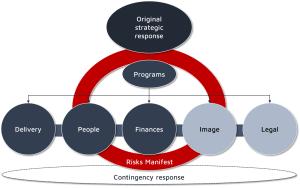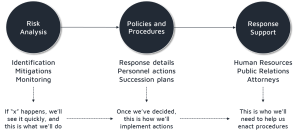6
“What if?” As non-profits confront the conditions created by Covid-19, this is a question they have to be prepared to answer. If they are unable to address critical issues quickly and effectively, their ability to serve the people who need them may be compromised, and they may face avoidable legal, financial, public relations, and other challenges.
Non-profits’ best laid plans can be derailed by a range of problems (examples below). Some may emerge over time, while others will manifest seemingly without warning.
- Ineffective delivery
- Funding shortfalls
- Interaction obstacles
- Exposures or infections
- Setbacks in “recovery”
Figure 9 (below) illustrates the key areas that may be impacted by risk manifestation. These are not minor, and the impacts can extend even to non-profits’ ability to continue operations. Advance preparation defining how organizations’ respond when problems arise—is essential to protecting non-profits and their capacity to serve.
Figure 9—Potential Areas of Covid-19 Risk Impacts

Every non-profit, therefore, needs to have a Covid-19 Contingency Plan detailing what it will do when potential risks become reality.[1] Figure 10 (next page) shows three key considerations for contingency planning. Non-profits have to ensure these elements are covered in the planning process in order to create an effective plan.
Figure 10—Key Considerations for Contingency Plans

It is worth emphasizing the importance of having strong monitoring mechanisms so non-profits can recognize risk manifestation. If organizations do not see performance problems, financial issues, Covid-19 related incidents, etc. early on, it is impossible to take efficient, effective action. This failure increases the impact of the problems.
An excellent approach to contingency planning is “scenario analysis.” Planners (e.g., Board members, executives, key staff, outside support) look at each high-priority risk and visualize the implications, define what policies and procedures will be necessary, and determine who will ensure actions are appropriate, legal, and effective.
Figure 11, below, provides an example of a scenario that could easily arise during the pandemic, and maps out the associated thought process non-profits might follow.
Figure 11—Example of Contingency Planning Scenario Map
| Scenario: On-site employee tests positive for Covid-19 | ||
| Scenario Impacts | Policies and Procedures | Required Support[2] |
| The employee is indefinitely out of work |
|
|
| Staff the person worked with are concerned |
|
|
| The individual had close contact with clients |
|
|
| News of the incident will likely become public |
|
|
In some cases, required support will be helpful in creating a contingency plan (e.g., Human Resources, Attorneys). It is equally important to engage resources quickly after the plan is developed. For example, a Public Relations consultant should be drafting templates in advance, so the response can be immediate when an incident occurs.[3]

Bottom line: Don’t wait until something happens. Plan ahead to outline event responses and get the necessary policies, procedures, and help in place. A contingency plan for the Covid-19 pandemic isn’t just “nice to have.” With the uncertainty and instability in the environment, and the potential impacts of issues and events, it’s essential.

Go to Session 4 presentation and recordings for a more detailed discussion
- Ideally, most non-profits will have risk management plans during “normal” times. During Covid-19, the need is particularly urgent. ↵
- In-house or external resources, depending on non-profits’ capacity. ↵
- In smaller non-profits in particular, acquiring support resources may require establishing new internal roles (and/or procuring outside help (e.g., General Contractors, Human Resources, Attorneys, Public Relations). Regardless of how resources are acquired, however, it is critical that they have sufficient expertise in the subject matter—“enough knowledge to be dangerous” isn’t enough knowledge! ↵
